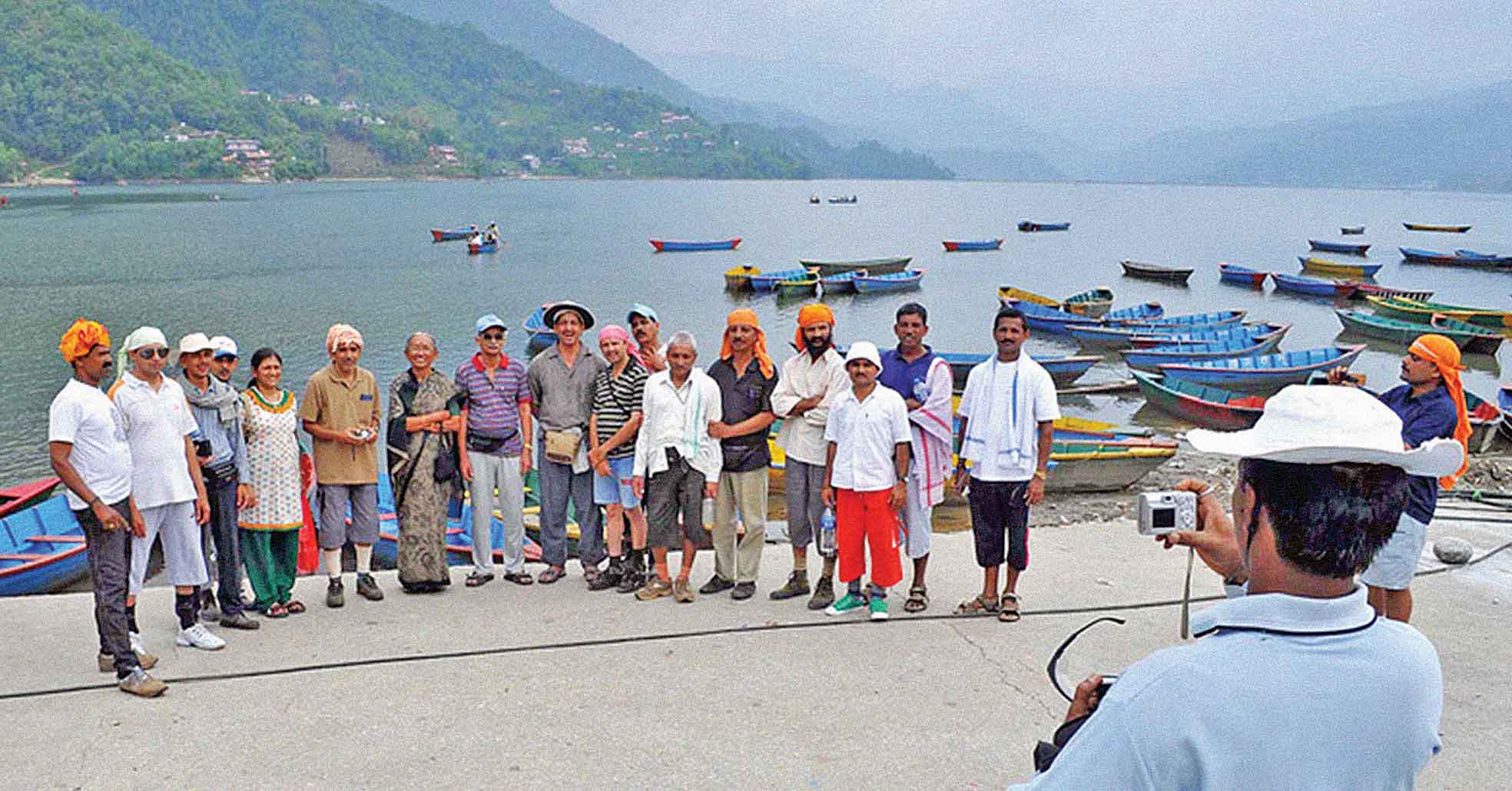
The country can reap benefits from the increasing outbound travelers from neighbouring India through serious efforts of promotion and marketing of Nepal in various states of India and addressing key issues that have been hindering the enhancement of bilateral tourism promotion. Numbers of Indian outbound travelers has been increasing each year to touch 50 million by 2020 according to the forecast of the World Travel and Tourism Council. Indian travelers are considered to be the second largest spenders - after Chinese - for overseas travel, and such expenses is expected to reach $91 billion by 2030. Sound growth of the Indian economy and burgeoning population of India are credible factors to back these projections. It is reported that Indian travelers take an international holiday once in 12-18 months. Although numbers of Indian outbound travelers have been growing, the flow of Indian tourists to Nepal has seen a steady decline. Around 800,000 travelers visit Nepal every year, among them around 20 percent are Indians.
Nepal and India share 1,808 km long open border and also historical, socio-cultural and economic ties, which is why tourism promotion in India is relatively easier when compared to other destinations. Nepal was an attractive destination for Indian tourists in the past, however, expensive air fare, closure of casinos and lack of attention regarding tourism promotion in India are the major reasons for reduction of inflow of Indian tourists. Aggressive promotion of other tourism destinations like Dubai, Bangkok, Singapore, Kula Lumpur and Bali, among others in India, have been instrumental in Indian tourists being attracted towards these destinations now. International airlines had higher airfare in the Kathmandu-Delhi sector before Nepal Airlines added flights to Delhi. This was a hindering factor for tourism growth from India to Nepal, according to Sugat Ratna Kangsakar, Managing Director of Nepal Airlines Corporation (NAC). “In addition, the national flag carrier has started operating flights to Bangalore as well to enhance the tourism sector,” he adds. Following the sluggish tourist inflow especially from the US and Europe in the wake of last year’s earthquake, Nepal has been focusing on neighbouring India and China to bring in more tourists.
Nepal and India have also signed a cooperation agreement for tourism on November 25, 2014. The agreement has recognised the sectors of cooperation in tourism between two countries. Based on the agreement a joint working group comprising private sector was formed to initiate necessary steps for promoting tourism. The joint working group meeting held last year in Delhi discussed developing better tour packages, joint promotion of Nepal and India in international markets, improving connectivity and encouraging low cost carriers among others to make the cooperation durable and effective, according to Tourism Secretary, Prem Kumar Rai. Stakeholders have identified some key issues to be addressed to increase the flow of tourists in both countries.
Implementation of Leave Travel Concession scheme of Indian government
The government of India has granted leave travel concession (LTC) for its more than two million government employees and Nepal is listed as an accredited destination by the Government of India along with Bhutan, Maldives and Sri Lanka. However execution of the scheme is pending due to lack of initiative from both sides. Tourism entrepreneurs believe that implementation of LTC scheme will bring transformational change in the country’s tourism sector. Ghanshyam Upadhyay, Joint Secretary at the Ministry of Culture, Tourism and Civil Aviation (MoCTCA) claims that the next meeting of the Joint Working Group on Tourism Promotion will give emphasis on the execution of LTC scheme.
Improving air connectivity to boost tourism
Improving air connectivity from different cities of Nepal to India and vice-versa could be instrumental to boost tourism sector. Nepal has not been able to establish air connectivity with various cities of India from Bhairahawa, Biratnagar, Nepalgunj and other airports. Currently, Nepali carriers are permitted to fly to 21 destinations in India as per the recently revised air service agreement. However, Nepali carriers are reluctant to establish flight connectivity to Indian cities from afore mentioned airports due to the lack of optional entry points. Though there are five exit points—Bhairahawa, Biratnagar, Kakarbhitta, Janakpur and Mahendranagar—for international airlines, Simara is the only entry point for carriers flying into Nepal, which often suffers from traffic congestion. Nepali carrier Buddha Air had started flight to Vanarasi few years back, but the airline operator halted the service as it became unviable, says Parashar Jung Pandey, Senior Sales and Marketing Manager of Buddha Air. “Buddha Air also had to abandon its plan to operate Pokhara-Bhairahawa-Lucknow flights due to the air route problem. It had been allowed to fly from Pokhara to Lucknow; but on the return flight, it had to enter Nepal through the Simara point which made the service economically unviable,” he shares. Stakeholders have suggested the government to add more entry points to enter to the Nepali air space. The importance of air routes was realised when the plans of Nepali carriers to expand cross-border flights were thwarted due to the absence of adequate entry points. If more entry routes are added, chances are high that many low cost carriers will be encouraged to create direct flights from other Indian cities like Amritsar, Lucknow and others connecting directly to Nepali airports.
Currency limit and ban in higher denominations
Currency has also been identified as another hassle in enhancing flow of tourists from India. Nepalis travelling to India cannot withdraw more than INR 15,000 per day from ATMs and there are complaints of the cards being unaccepted. On other hand, Indians flying into Nepal are allowed to carry a maximum of INR 25,000 in cash. However Indian air travelers are unable to take the money back; they have to spend all the money in Nepal. Moreover, those travelling via land complain of restrictions in bringing large denominations of Indian currency like INR 500 and 1000.
Relaxation on tourist visa provision and joint promotion
Though Nepali and Indian nationals do not require visa policy to travel to each other’s’ nation, Indian government’s visa policy for tourists has been hindering the joint tourism promotion. Foreign nationals holding tourist visa of India with multiple entry facility should have a gap at least two months between visits to India. This provision has been hindering Nepal in joining hands with Indian tourism promotion bodies for joint promotion in the international market and introducing joint travel packages. Many tourists from India come to visit Lumbini without carrying passport and travel document. “This has become a source of bribery for immigration officers at the border of both sides. Indian immigration allows tourists to travel to Nepal as Indian nationals and Nepali immigration officers also do the same without travel document passing them as Indian nationals in immigration documents,” a high level source at the Nepal Tourism Board claims adding, “It is easy for tourists to obtain Nepal’s visa because Nepali immigration provides them visa on arrival. If they come with travel document as per the visa policy of the Indian government, tourists cannot re-enter India for two months before date of departure from India.”
Shreejana Rana, Vice President of Hotel Association Nepal believes that if India relaxes this visa provision, tourists who visit India can come to Nepal as well. Nepal and India can also jointly launch tourism promotion programmes in international markets. A strong bilateral tourism promotion between both countries as well as to market both destinations together globally could be instrumental in bilateral tourism promotion.
In addition, there is also need to collaborate with State tourism bodies in India directly rather than at the government level. This has been identified as a critical issue as many people in India are still unaware of Nepal as a tourism destination, Rana further stated.
Negative Travel Advisory
Neighbouring India has always supported Nepal in its initiative of tourism promotion. Many countries have issued negative travel advisory in the wake of the devastating earthquake last year which have now been lifted, yet India never issued a negative travel advisory for Nepal. But tourism stakeholders are concerned that India recently chose to issue a negative travel advisory for travel to Kailash Mansarovar via Nepal.
Investing in the Tourism Industry in Nepal
Bringing Indian chains to Nepal can play an important role in bringing more tourists to Nepal. Some months back, Rahul Chaudhary, MD of CG Hotels and Resorts announced the opening of a luxury resort named Meghauli Serai in Chitwan under the Taj Safari brand. The affiliation with Meghauli Serai marks Taj’s comeback in Nepal after 12 years. Earlier, Taj had operated Hotel Annapurna, but had pulled out in 2004 as unfavorable situation prolonged with the insurgency. Taj Hotels Resorts and Palaces of India promotes the Megahuli Serai in the global market along with its other hotel chains.
While much can be done to promote bilateral tourism between the two countries, there is a lack of urgency to address these issues from Nepal’s side. What policy makers possibly fail to remember is that the options are many for the world traveler, it is up to a country to upgrade and market itself as a preferred destination and not rest on old laurels and diminishing efforts.



-1765706286.jpg)
-1765699753.jpg)

